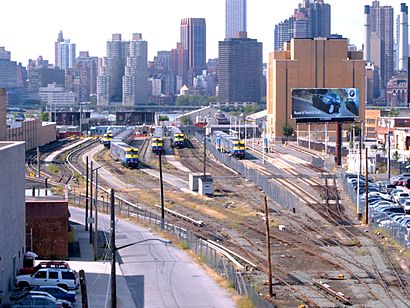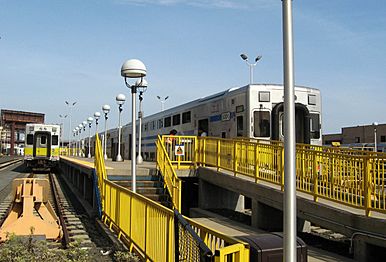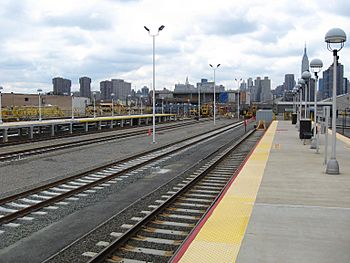Long Island City station facts for kids
|
||||||||||||||||||||||||||||||||||||||||||||||||||||||||||||||||||||||||||||||||||||||
Long Island City is a train station in Queens, New York City. It's the very last stop, or terminal, for some trains on the Long Island Rail Road (LIRR). You can find it in the Hunters Point and Long Island City areas.
The station is located at Borden Avenue and Second Street. It's the furthest west LIRR station in Queens. It marks the end of two important train lines: the Main Line and the Montauk Branch. The station has one platform where passengers get on and off trains. It's at ground level and is easy to use for people in wheelchairs.
Contents
Train Services at Long Island City
This station is mainly used during busy weekday hours. Trains run in the morning towards Long Island City and in the evening away from it. These trains come from the Oyster Bay, Montauk, or Port Jefferson lines. They travel along the Main Line.
Before November 2012, some LIRR trains also used a different route, the Lower Montauk Branch, to reach this station.
History of the Station
Early Days and Rebuilds
The Long Island City station first opened a long time ago, on June 26, 1854. Over the years, it was rebuilt many times. In fact, it was rebuilt seven times during the 1800s!
On December 18, 1902, a fire destroyed both the station building and the LIRR office building. But they didn't give up! A new, fire-proof station was built and opened on April 26, 1903. Electric trains started serving the station on June 16, 1910.
Connecting to Manhattan
Before the East River Tunnels were built, this station was super important. It was the main way for people traveling from Long Island to get to Manhattan. Passengers would arrive at Long Island City and then take ferry boats across the East River. These ferries would take them to places like the East 34th Street Ferry Landing or the James Slip Ferry Port in Manhattan.
The passenger ferry service stopped on March 3, 1925. However, today you can still catch a ferry from nearby, operated by NYC Ferry.
Freight and Modern Changes
There used to be special train tracks that connected to car floats. These were like giant barges that could carry entire freight trains across the water to Manhattan and New Jersey. This was important for moving goods until the mid-1900s. Today, the area where these car floats operated is now a park called Gantry Plaza State Park.
In 1939, the station house was torn down again. This happened because they were building the Queens–Midtown Tunnel, a big tunnel under the East River. Even though the building was gone, the station kept running as an active train stop during the tunnel's construction and after it opened.
Station Layout
The Long Island City station has 13 tracks for trains. It also has three concrete island platforms, which are platforms with tracks on both sides.
Platform A is the northernmost platform. It's long enough for two train cars and you can get to it from Borden Avenue. The other two platforms, Platform B and Platform C, are inside a secure area of the train yard. They are mostly used by employees and not for regular passenger service.
Many of the tracks without platforms are used to store trains when they are not in use. The six tracks closest to the south side of the station get their power from a third rail. This means they can be used by electric trains. The other tracks are only used by diesel-powered trains.
| P Platform level |
Street level | Exit/entrance, ticket machine, access to ferry, buses, and subway |
| Track 0 | Storage track → | |
| Track 1 | Storage track → | |
| Track 2 | Port Jefferson Branch toward Huntington or Port Jefferson (Hunterspoint Avenue) → Oyster Bay Branch toward Oyster Bay (Hunterspoint Avenue) → Montauk Branch toward Patchogue, Speonk or Montauk (Hunterspoint Avenue) → |
|
| Platform A, island platform | ||
| Track 3 | Port Jefferson Branch toward Huntington or Port Jefferson (Hunterspoint Avenue) → Oyster Bay Branch toward Oyster Bay (Hunterspoint Avenue) → Montauk Branch toward Patchogue, Speonk or Montauk (Hunterspoint Avenue) → |
|
| Track 4 | Storage track → | |
| Track 5 | Storage track → | |
| Track 6 | Storage track → | |
| Platform B, no regular service | ||
| Track 7 | Storage track → | |
| Track 8 | Storage track → | |
| Platform C, no regular service | ||
| Track 9 | Storage track → | |
| Track 10 | Storage track → | |
| Track 11 | Storage track → | |
| Track 12 | Storage track → | |
Gallery
- Long Island City
- Long Island City – LIRR
- Long Island City LIRR timetable





